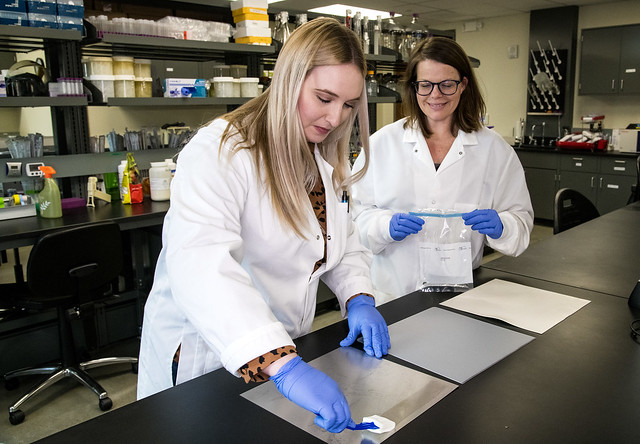March 13, 2020
Arkansas researchers investigate effectiveness
of microorganism monitoring tools
By Fred Miller
U of A System Division of Agriculture
@AgNews479
Fast facts
- FDA requires environmental monitoring for microorganisms in food industries
- Tools and methods vary widely
- Division researcher investigates effectiveness of materials, tools, methods
(720 words)
Download MS Word version here
Download related PHOTOS from Flickr: https://flic.kr/s/aHsmLNaDwu
FAYETTEVILLE, Ark. — U.S. Food and Drug Administration regulations emphasize effective monitoring for pathogens in food processing facilities, but lack standardization for environmental monitoring programs across the country, said Kristen Gibson, University of Arkansas System Division of Agriculture food scientist.
At the crux of the issue is the variety of materials and shapes of swabs used to collect samples from surfaces, said Gibson, who is an associate professor of food safety and microbiology for the Arkansas Agricultural Experiment Station.
“Food recalls because of contamination are based on finding pathogenic microorganisms in food industry workspaces,” Gibson said. These microorganisms are typically bacteria that can cause illness in those who eat the food products, she said.
Individual companies have different preferences in the swabs they use to check work surfaces. Gibson said the most common swab materials are cellulose and polyurethane foam, but there is little research-based information on their performance.
An effective swab must capture microorganisms from a variety of surfaces, Gibson said. Then it must release them into an elution buffer, a liquid medium that is used to remove the samples from the swabs and analyze them for the presence of pathogens.
The FDA’s Food Safety and Modernization Act requires environmental monitoring but sets no standards for tools or procedures, said Sarah Jones, a Ph.D. student in Dale Bumpers College of Agricultural, Food and Life Sciences at the University of Arkansas.
Investigation
Jones is conducting her graduate research with Gibson, investigating the effectiveness of cellulose and polyurethane foam swabs. Her goal is to determine which material is best suited to pick up microorganisms from a surface, release them for analysis, and effectively remove operator error from the process.
Because different food processing environments have varying conditions, she is testing the swabs on different surfaces and using controlled environments to test swab function under varying temperatures and humidity levels.
Cellulose swabs, she said, have demonstrated considerable variability in their ability to lift microorganisms and release them.
“Many food companies have stopped using cellulose,” Jones said, “because it is prone to breaking apart on coarse surfaces. But some companies continue to use it.”
Polyurethane foam, she said, shows less variability in performance. The polyurethane foam especially proves more efficient than cellulose in releasing microorganisms into the elution buffer used for detection, Jones said.
Jones inoculates the swabs, applying the bacteria directly onto the material, to measure how effectively they release the pathogens when placed into elution buffer.
“We get a higher rate of release from the polyurethane foam, but we don’t know why. We want to explore ways of improving sensitivity of the materials,” Jones said.
Effectiveness of capture and especially of release also varies depending on the microorganism present, Gibson said. They use two common bacteria in their research — Salmonella Typhimurium and Listeria monocytogenes.
“Their cell membranes are different,” Gibson said, “and we think they interact differently with the swab materials. But we don’t know the root cause of the recovery and release not being equal between the microorganisms.” Gibson said similar variability is expected when monitoring for viruses.
The FDA does not require food companies to monitor for viruses because they tend to be host-specific and not given to contaminating different kinds of foods. Testing for viruses is most useful for discovering patterns of contamination and transmission during a viral outbreak, Gibson said.
Next Steps
Gibson said the variability in capture and release between different microorganisms raises questions for further investigation. “What can we do to make these materials work equally for different bacteria or viruses? Or should we use different materials and design swabs specific to each pathogen? What might make them want to release?”
One possibility to investigate is that, under ambient conditions, most microorganisms have a negative charge, Gibson said. It’s possible that could play a role in binding to surfaces.
If that proves to be true, Gibson suggested, swabs could be prepared with a positive charge to attract them. The charge could then be reversed in the elution buffer to separate the microorganisms from the swabs.
Further research may discover other additives that can be applied to the base matrix of polyurethane foam to make the capture of microorganisms more sensitive and release more efficient. As her research continues, Gibson said she wants to use microscopy to see how the microorganisms behave in the polyurethane foam matrix.
To learn more about Division of Agriculture research, visit the Arkansas Agricultural Experiment Station website: https://aaes.uark.edu. Follow us on Twitter at @ArkAgResearch and Instagram at ArkAgResearch.
About the Division of Agriculture
The University of Arkansas System Division of Agriculture’s mission is to strengthen agriculture, communities, and families by connecting trusted research to the adoption of best practices. Through the Agricultural Experiment Station and the Cooperative Extension Service, the Division of Agriculture conducts research and extension work within the nation’s historic land grant education system.
The Division of Agriculture is one of 20 entities within the University of Arkansas System. It has offices in all 75 counties in Arkansas and faculty on five system campuses.
Pursuant to 7 CFR § 15.3, the University of Arkansas System Division of Agriculture offers all its Extension and Research programs and services (including employment) without regard to race, color, sex, national origin, religion, age, disability, marital or veteran status, genetic information, sexual preference, pregnancy or any other legally protected status, and is an equal opportunity institution.
Media Contact: Fred Miller
U of A System Division of Agriculture
Arkansas Agricultural Experiment Station
(479) 575-5647
fmiller@uark.edu
Related Links
